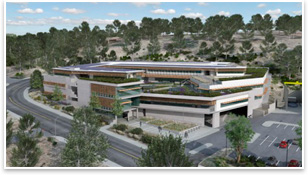NOAA Breaks Ground on Stimulus-Funded Science
Center
$102 million building to replace older facility in La Jolla, Calif.

The NOAA’s Southwest Fisheries Science Center
in La Jolla, Calif. Image courtesy of Gould Evans.
The National Oceanic and Atmospheric
Administration (NOAA)
is breaking ground this month on a new economic stimulus-funded building.
Its $102 million Southwest Fisheries Science Center in La Jolla,
Calif., will be part of the University of California-San Diego campus
and will replace an older facility. The architect of record is Gould
Evans of
Kansas City, Mo., and the associate architects are Architects
Delawie Wilkes Rodrigues Barker of San Diego.
This project is part of $600 million NOAA received
from the American Recovery and Reinvestment Act economic stimulus
package. This amount also includes $9 million to upgrade NOAA weather
forecast offices in Barrow and Nome, Alaska, $142 million to complete
the construction of its Pacific Regional Center in Honolulu, and
$9 million to construct a replacement of a Fairbanks, Alaska satellite
facility. These projects are a small percentage of the $130 billion
worth of design and construction initiatives that the AIA estimates
are included in the economic stimulus package and are reflected in
the AIA’s Rebuild and Renew government advocacy plan.
When the science center is completed in 2011, it is expected to
be LEED Gold certified, and will house 283 staff members in lab and
office spaces. The facility will perform research for the NOAA’s
National Marine Fisheries Service and
will contain a large seawater and freshwater Ocean Technology Development
Tank that will be used to study and survey fishery resources and
ecosystems. Last year, AIA San Diego gave the unbuilt design an honor
award.
“This has been one of the most interesting and challenging
projects that our firm has ever had the opportunity to design,” says
Bob Gould, FAIA, co-founder of Gould Evans, in a press release. “We
were provided with an extremely steep site, facing west toward the
Pacific Ocean, and a relatively complex building program which includes
laboratories, offices, and enclosed parking. The project evolved
through the design process in a manner that maintains views over
the site for neighbors, maximizes views from the site to La Jolla
cove, and utilizes a series of courtyards and light wells to optimize
the use of daylight and fresh air. We intend for this to be a significant
addition to the University of California at San Diego campus and
a great place for the NOAA researchers to do their important work.” |


